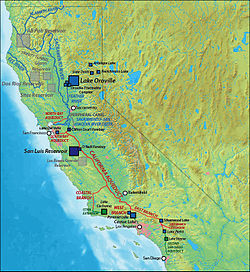For example, you can build water towers 100 to 500 or more feet high and then use little solar powered pumps which might be 1/4 inch or less in diameter so those little solar powered pumps can raise the water that high during the day. You also could make a bigger solar array, store the power in a Tesla Wall, for example, and pump water up to a very high tank 24 hours a day by generating power from the sun during the day and using the stored battery power at night. A little solar powered pump can pump a lot of water if it is non-stop 24 hours a day.
They had a set up like this at my younger daughter's private school which one awards from both Governor
Arnold Schwarzenegger of California and President Bush as one of the Greenest Private Schools in the U.S. She was there from age 7 to 12. It was up on a hill and had solar power to everything, and waterless urinals which inspired schools and businesses throughout the area here in California to do the same starting right then. In fact, China sent 15 emissaries from the department if Education and was considering building 15,000 schools just like this in China by duplicating every process from teaching to solar etc. within those schools. This likely was around 2006. They were considering duplicating the whole plant from teaching methods to solar power to recycled materials etc. which was very ahead of it's time in total.
So, all the water to the school was brought up from the well by a little 1/4 inch pipe which really amazed me. It was that water could be drawn up to a water tank through this pipe could be pumped every sunny day of which most days were where this school is located year around.
On another level altitude is not a problem if you want the water the other side of a mountain (as long as the ending altitude isn't too high. So, for example, they did this bringing water to Los Angeles from northern California. The California coastal range is a problem though to get the water over it into Los Angeles over the Coastal range. They solved the problem with a type of syphon.
First they built a pipe system over the Coastal Range of California. Then they shut the valves at the bottom of either side. Then they pumped through smaller hoses water in at the top of the range into the pipes. Once you had the water weight displaced from one side of the Coastal range of Mountains to the other it then takes very little pump power to move the water from one side to the other the size of a good sized river 20 to 30 feet wide and likely 15 feet deep.
So, using this method one can easily transport desalinated water from one side of a mountain range to the other as long as the starting point and ending point are around the same altitude.
The problem becomes, however, if you want to move water from the ocean up to 3000 to 10,000 feet in altitude. Then you either need to take water trucks and drive it or use little electric or solar powered pumps in stages up to that altitude.
So, this is where desalination doesn't have a solution if there are mountain areas that have drought yet.
However, if there were a cost effective way to do this then huge water storage tanks could be built on top of mountains and water with incredible pressure would be available almost anywhere within a few hundred miles of those mountains through pipes. You would likely need pressure reducers at some points along the way to keep pipes from blowing up from the pressure at lower altitudes.
- The California State Water Project, commonly known as the SWP, is a state water management project in the...
Map showing major features of the project (SWP reservoirs in blue, SWP/CVP reservoirs in dark blue, and unbuilt/proposed facilities in gray)
| General statistics | |
|---|---|
| Begun | 1960 |
| Storage dams | 10 |
| Additional dams | 4 (reregulation) 4 (hydroelectric) 2 (flood control) 1 (mitigation/conservation) |
| Power plants | 5 conventional 3 pumped-storage |
| Canals | 701.5 miles (1,129.0 km) |
| Operations | |
| Storage capacity | 5,746,790 acre feet (7.08856×109 m3) |
| Annual water yield | 2,400,000 acre feet (3.0×109 m3)[1] |
| Land irrigated | 750,000 acres (300,000 ha) |
| Power plant capacity | 2,991.7 MW |
| Annual generation | 6500 GWh |
| Annual consumption | 11500 GWh |
| Constituencies served | Greater Los Angeles Area Greater San Diego Inland Empire San Francisco Bay Area North Bay Santa Clara Valley South Bay Central Coast San Joaquin Valley |

No comments:
Post a Comment